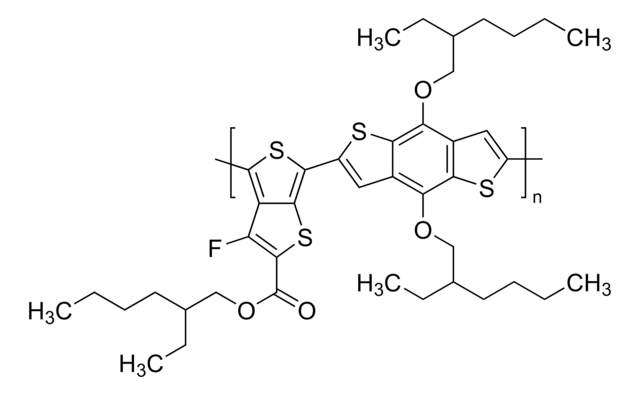753998
PCDTBT
Synonym(e):
Poly[N-9′-heptadecanyl-2,7-carbazole-alt-5,5-(4′,7′-di-2-thienyl-2′,1′,3′-benzothiadiazole)], Poly[[9-(1-octylnonyl)-9H-carbazole-2,7-diyl]-2,5-thiophenediyl-2,1,3-benzothiadiazole-4,7-diyl-2,5-thiophenediyl]
About This Item
Empfohlene Produkte
Beschreibung
Band gap: 1.9 eV
Form
solid
Mol-Gew.
average Mw 100,000-140,000
Verlust
0.5 wt. % TGA, 409 °C
mp (Schmelzpunkt)
270-300 °C
Übergangstemp.
Tm >400 °C
λmax
576 nm
Energie der Orbitale
HOMO -5.5 eV
LUMO -3.6 eV
Leistung von OPV-Bauelementen
ITO/MoO3-Al/PCDTBT:PC71BM/MoO3/Al
ITO/PEDOT:PSS/PCDTBT:PC71BM (1:4)/TiOxAl
ITO/PEDOT:PSS/PCDTBT:PC71BM/Al
Halbleitereigenschaften
P-type (mobility=6×10−5 cm2/V·s)
Suchen Sie nach ähnlichen Produkten? Aufrufen Leitfaden zum Produktvergleich
Allgemeine Beschreibung
Anwendung
Lagerklassenschlüssel
11 - Combustible Solids
WGK
WGK 3
Flammpunkt (°F)
Not applicable
Flammpunkt (°C)
Not applicable
Analysenzertifikate (COA)
Suchen Sie nach Analysenzertifikate (COA), indem Sie die Lot-/Chargennummer des Produkts eingeben. Lot- und Chargennummern sind auf dem Produktetikett hinter den Wörtern ‘Lot’ oder ‘Batch’ (Lot oder Charge) zu finden.
Besitzen Sie dieses Produkt bereits?
In der Dokumentenbibliothek finden Sie die Dokumentation zu den Produkten, die Sie kürzlich erworben haben.
Kunden haben sich ebenfalls angesehen
Artikel
The development of high-performance conjugated organic molecules and polymers has received widespread attention in industrial and academic research.
Organic materials in optoelectronic devices like LEDs and solar cells are of significant academic and commercial interest.
Organic photovoltaics (OPVs) represent a low-cost, lightweight, and scalable alternative to conventional solar cells. While significant progress has been made in the development of conventional bulk heterojunction cells, new approaches are required to achieve the performance and stability necessary to enable commercially successful OPVs.
Thin, lightweight, and flexible electronic devices meet widespread demand for scalable, portable, and robust technology.
Unser Team von Wissenschaftlern verfügt über Erfahrung in allen Forschungsbereichen einschließlich Life Science, Materialwissenschaften, chemischer Synthese, Chromatographie, Analytik und vielen mehr..
Setzen Sie sich mit dem technischen Dienst in Verbindung.

![Poly-[(9,9-di-n-octylfluorenyl-2,7-diyl)-alt-(benzo[2,1,3]thiadiazol-4,8-diyl)] average Mn ≤25000](/deepweb/assets/sigmaaldrich/product/structures/428/661/1c4ebb98-9d51-48c0-96c7-e556ca425aa4/640/1c4ebb98-9d51-48c0-96c7-e556ca425aa4.png)



![[6,6]-Phenyl C71 Buttersäuremethylester, Isomerengemisch 99%](/deepweb/assets/sigmaaldrich/product/structures/716/624/9fb9f2f0-ae99-429f-8d3a-b12267976a4d/640/9fb9f2f0-ae99-429f-8d3a-b12267976a4d.png)



![Poly-[(9,9-dioctylfluorenyl-2,7-diyl)-co-bithiophen] 99.9%](/deepweb/assets/sigmaaldrich/product/structures/309/000/8b4a3f54-7765-4aca-96c4-74ce328d455d/640/8b4a3f54-7765-4aca-96c4-74ce328d455d.png)